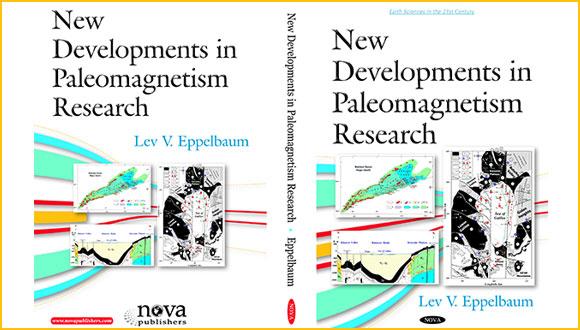Dr. Lev Eppelbaum is the editor of a new book and the author of one chapter
Paleomagnetic mapping of different areas of Israel (e.g., Lake Kinneret, Makhtesh Ramon) and Eastern Mediterranean is considered in detail in the chapter Dr. Eppelbaum wrote
This book presents recent achievements in the different fields of paleomagnetism. Paleomagnetic field analysis occupies a separate place in the variety of studied physical parameters since assists us to obtain some specific ‘stamps’ of the past geomagnetic field configurations. It is well known that the life at the Earth and all geological-environmental processes occur in the changing geomagnetic field (the Earth’s magnetic field intensity is now decreasing). Geological-geophysical records indicate that hundreds and hundreds Earth’s magnetic field reversals have occurred. Paleomagnetic research enables to reveal an information about ancient (from hundreds to billions years) magnetic field changing which reflects definite geological, archaeological, cosmological and environmental events of that time. Some geodynamic and tectonic information derived from the paleomagnetic field analysis cannot be obtained in principle by any other geophysical or geological methods.
Eppelbaum and Katz's Chapter ("Paleomagnetic Mapping in Various Areas of the Easternmost Mediterranean Based on an Integrated Geological-geophysical Analysis") is suggested to methodology of paleomagnetic mapping in tectonically complex collision zones.
A first paleomagnetic-radiometric map of the Sea of Galilee and its surroundings enabled us to reveal the zones of predominantly direct and inverse polarity (the Brunhes, Matuyama, Gauss, Gilbert and more ancient epochs), and to define the tectonic-structural pattern of the area under study. Results of 3-D physical-geological models along the profile through the Sea of Galilee enabled us to find the reversely magnetized Earth’s crust block (Neoproterozoic ?) within the Galilee-Lebanon terrane. On the basis of a comprehensive examination of paleomagnetic, radiometric and tectono-structural data in Makhtesh Ramon (the Ramon Crater in Israel’s Negev Desert), a first paleomagnetic map of this area was constructed, and the Illawarra, Omolon, Gissar and Jalal hyperzones were contoured. The analysis of magnetic, radiometric, and structural-geological data in the Hameishar region (south of Makhtesh Ramon) indicates that basaltoids apparently relating to the Illawarra paleomagnetic hyperzone had developed. For an analysis of geodynamic history and tectonic patterns of the easternmost Mediterranean oceanic crust, a detailed paleomagnetic examination, combined with magnetic, gravity, seismic, and other geophysical methods analysis, radiometric dating, and numerous geological methods have been applied. The delineated block of inverse magnetization of submeridional strike in the easternmost Mediterranean (with a width reaching 70 km, length about 200 km, and vertical thickness about 10 km) was identified as a Kiama hyperzone of inverse polarity. All the obtained results are important for tectonic, geodynamic and structural reconstructions in the region under study.





